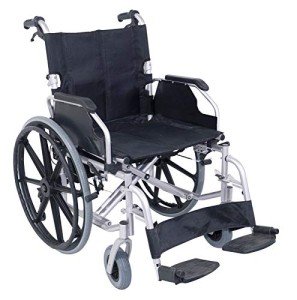Bariatric Wheelchair Seat Width
Seat Width
Having the correct seat width is essential to wheelchair users who invest longer durations in their chairs. Too narrow a seat will cause pressure on the hips and thighs which could lead to sores or pressure points. Having too wide a seat can likewise make it tough for the user to reach the hand rims to propel themselves or maneuver in small spaces.
To measure the appropriate seat width a person would rest on a chair usually and have their measurement taken across their lap at the widest point which is normally their hips. A wheelchair determining tape can be utilized to measure this, but a lawn stick is chosen as it prevents individuals from covering the tape around their hips which would provide an incorrect result.
bariatric wheelchair 24 inch seat is 16" (narrow grownup), 18" (standard grownup), and 20" (large adult). For bariatric patients, a 24" seat is readily available. This durable additional wide bariatric wheelchair from Medline includes swing-away footrests, a carbon steel frame with rust- and chip-resistant chrome plating, and easy-to-clean vinyl upholstery. It has a weight capacity of 500 pounds.
Seat Depth

Typically, the seat depth of a bariatric wheelchair was added 2" to the measurement taken at the user's largest point (generally their hips). This was suggested to accommodate extra layers of clothes that might be used throughout cold weather condition. However, this practice is becoming less typical as wheelchair users are able to spend more time inside your home and are not wearing long coats. This makes the seat depth of a chair less important when selecting a bariatric wheelchair. However, it is still essential to choose an option that provides sufficient assistance for larger users.
The Medline folding extra wide bariatric manual wheelchair features a comfy 24" seat width and a durable slide tube silver vein frame. It likewise has an adjustable axle and tool-free raising legrests.
Seat Height
When it concerns determining the right wheelchair seat width you should constantly determine from the user's widest point which is generally their hips. You will also require to consider whether the user is going to be using a winter coat as this may add 2" to the width required.
When a wheelchair remains in usage it should just be operated on level surfaces with the wheel locks completely engaged. This is to avoid the chair from being able to move inclines that are 10 degrees or higher. It is also crucial to bear in mind that any activity that may shift the center of mass in the chair ought to be finished with care. This includes grabbing products that require the individual to lean out of their seat or trying to stand up from it.
Whenever you have the chair in usage it is advised that you frequently inspect it for damage and oil any locations that are deemed needed. For example, the casters must be oiled by getting rid of the caster fork and using a multi-purpose grease to use to the caster stem bearings. Similarly, the foot plates can be adjusted by loosening up the bolt and after that moving them to the wanted position. bariatric wheelchair 22 inch permits the feet to sit comfortably on the footplate and avoids any pressure points from forming. This can be extremely unpleasant for the user and if left ignored, can lead to pressure sores.
Weight Capacity
Bariatric wheelchairs are created to support more weight than standard wheelchairs. This makes them tougher and much better geared up to manage falls. They are also typically larger and larger, making them less maneuverable in tight spaces than standard wheelchairs. They require automobiles with unique ramps and lifts to load them, along with chauffeurs who understand how to best transport them from one area to the next.
When picking a wheelchair, consider its weight capacity as it will be the primary determining consider whether it will accommodate your traveler's requirements. The weight capacity of the chair is frequently listed as a fixed load, implying that it suggests the amount of weight the chair can comfortably hold while stalling. However, some manufacturers likewise list an active load that is based on a drop test and can mimic the impact of somebody sitting down in the chair. This may be a more reputable measurement of the weight limit, depending on your requirements.
If you prepare to perform activities that move your center of mass in the seat (such as reaching for items), be sure to have front casters pointed in a forward direction and wheel locks engaged so the chair will not tip over. Also, check that casters are oiled regularly to prevent extreme wear and abrasions. The lubrication procedure involves getting rid of the fork, separating the caster from the wheel, and greasing the caster stem bearings with premium multi-purpose grease.
